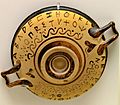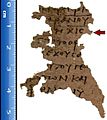Digamma facts for kids
 |
|||
Quick facts for kids Greek alphabet |
|||
|---|---|---|---|
| Αα | Alpha | Νν | Nu |
| Ββ | Beta | Ξξ | Xi |
| Γγ | Gamma | Οο | Omicron |
| Δδ | Delta | Ππ | Pi |
| Εε | Epsilon | Ρρ | Rho |
| Ζζ | Zeta | Σσ | Sigma |
| Ηη | Eta | Ττ | Tau |
| Θθ | Theta | Υυ | Upsilon |
| Ιι | Iota | Φφ | Phi |
| Κκ | Kappa | Χχ | Chi |
| Λλ | Lambda | Ψψ | Psi |
| Μμ | Mu | Ωω | Omega |
| Other letters | |||
| Ϝϝ | Digamma | Ϟϟ | Koppa |
| Ϛϛ | Stigma | Ϡϡ | Sampi |
| Ͱͱ | Heta | Ϸϸ | Sho |
| Ϻϻ | San | ||
Digamma (also called Wau) was an old letter in the Greek alphabet. It looked a lot like the letter "F" that we use today, but it was pronounced like the "w" sound in "water."
People stopped using Digamma around the 5th century BC because the "w" sound disappeared from the Greek language. However, they still used it as a special sign for the number "6" in their system of Greek numerals.
The letter was first called "Wau" because of the "w" sound it made. Later, after the sound was lost, it was called "Digamma." This name means "double Gamma" because it looks like the Greek letter Gamma (Γ) with two extra lines. The Latin letter F also came from Digamma.
See also
 In Spanish: Ϝ para niños
In Spanish: Ϝ para niños
Images for kids

All content from Kiddle encyclopedia articles (including the article images and facts) can be freely used under Attribution-ShareAlike license, unless stated otherwise. Cite this article:
Digamma Facts for Kids. Kiddle Encyclopedia.



